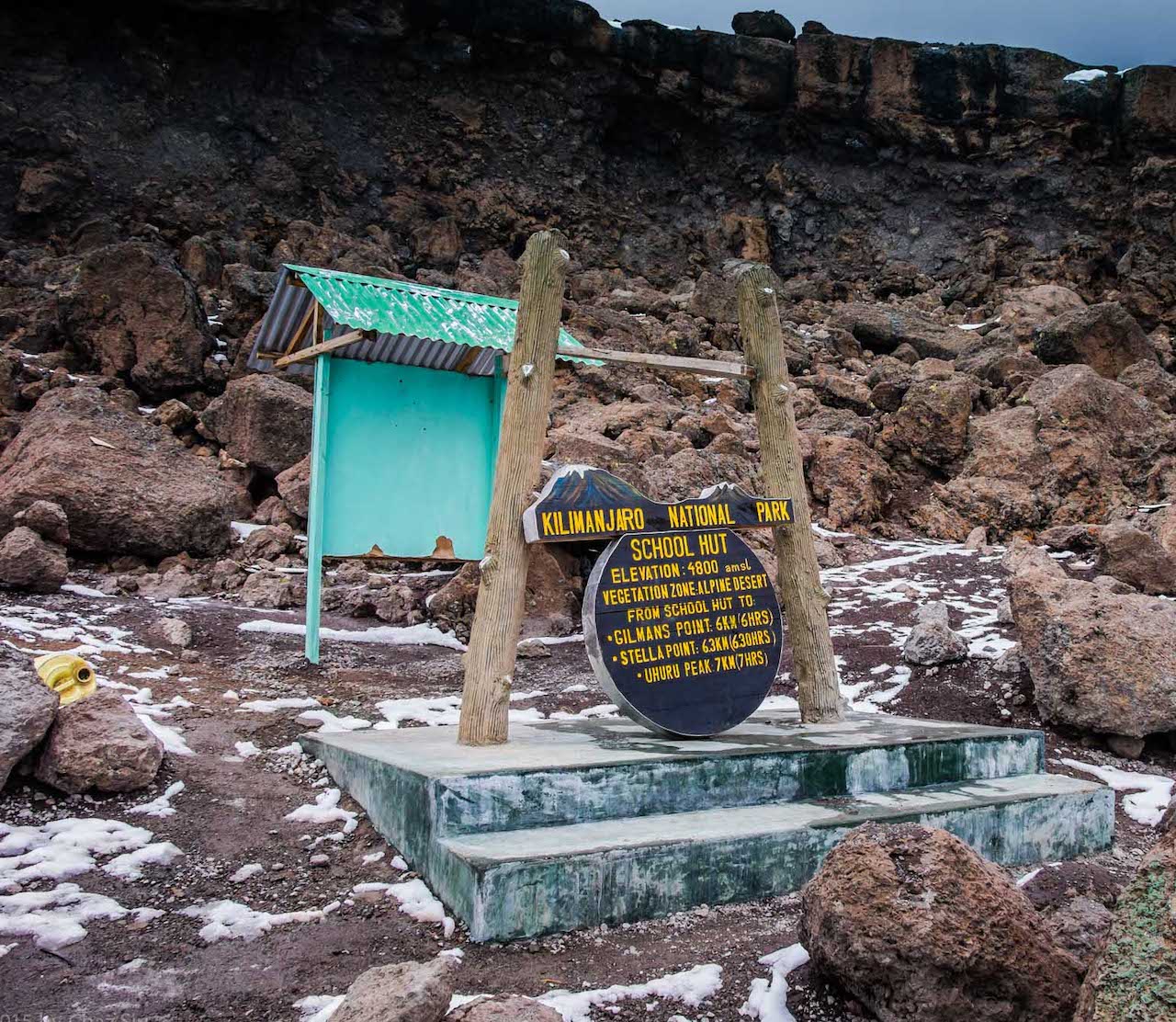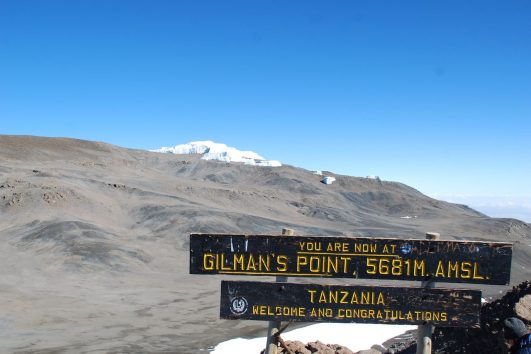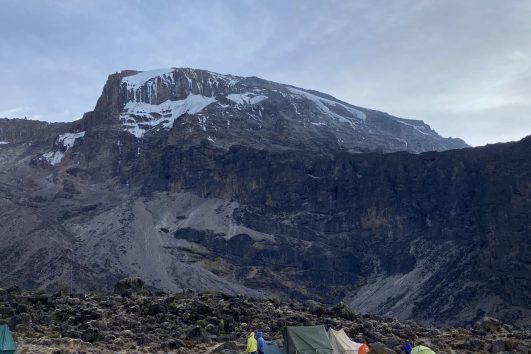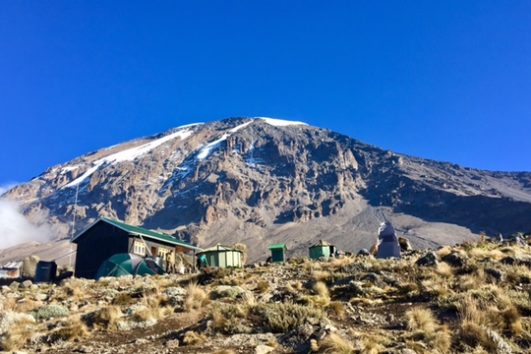School Hut Elevation: Approximately 4,800 meters (15,748 feet)
School Hut on Mount Kilimanjaro may not be as well-known as some of the more famous camps like Barafu or Karanga, but it holds a significant place in the Kilimanjaro trekking landscape. Located at an elevation of approximately 4,800 meters (15,748 feet), School Hut serves as an important high-altitude campsite for climbers taking the Rongai Route and the less-traveled Northern Circuit Route. It’s the last stop before attempting the summit of Kilimanjaro, making it a crucial resting point for trekkers looking to reach the iconic Uhuru Peak.
What makes School Hut special is not just its location, but the unique experience it offers. Tucked away on the quieter, northern side of the mountain, the camp offers a more secluded and serene atmosphere compared to the bustling southern routes. Climbers who stay at School Hut have a chance to rest and acclimatize in peace, surrounded by breathtaking views of the rugged alpine desert, before embarking on the final and most challenging leg of their journey. With the summit night just hours away, School Hut provides an essential refuge and a mental preparation point for what lies ahead.
The History and Origins of School Huts, Mount Kilimanjaro
The name “School Hut” has its roots in the early days of Mount Kilimanjaro expeditions. Originally, the site was used as a training ground for mountain guides and porters, hence the name “School.” The hut itself was constructed to accommodate and train local porters, preparing them to assist climbers on the ascent. Over time, as the number of trekkers increased and the infrastructure on Kilimanjaro developed, the site transitioned from a simple training camp into a key overnight stop for those using the Rongai and Northern Circuit Routes.
Despite its somewhat humble beginnings, School Hut has evolved into an important high-altitude camp for summit attempts. Today, the hut is still in use, although most climbers sleep in tents rather than the hut itself. The campsite has retained its historical charm while offering modern amenities like fresh water (when not frozen), decent space for tents, and some basic facilities, making it a comfortable base for summit night.
Why Choose School Hut Over Barafu Camp?
While many Kilimanjaro trekkers on other routes use Barafu Camp as their base before summiting, School Hut offers a quieter, less crowded alternative. For those on the Rongai or Northern Circuit routes, School Hut is strategically placed and provides an excellent acclimatization opportunity.
One of the biggest advantages of staying at School Hut is its seclusion. Unlike Barafu, which can be bustling with trekkers from multiple routes, School Hut typically hosts fewer climbers. This makes it an ideal spot for those seeking a more peaceful, less hurried experience on Kilimanjaro. The isolation also gives climbers a greater sense of connection to the raw, rugged environment of Kilimanjaro’s upper reaches, where the landscape transitions into the stark beauty of the alpine desert.
Additionally, the altitude at School Hut—slightly higher than Barafu—can offer climbers a better acclimatization opportunity. Spending the night here helps prepare your body for the higher elevations you’ll face as you ascend towards Gilman’s Point and finally, Uhuru Peak.
Summiting Mount Kilimanjaro from School Hut
From School Hut, the summit night begins early, usually around midnight, with climbers setting off under the light of headlamps. The climb from School Hut to Uhuru Peak, the highest point in Africa, is physically demanding, often considered the most challenging part of the entire Kilimanjaro trek.
The ascent begins with a steep climb to Gilman’s Point, located at the rim of Kilimanjaro’s crater at 5,685 meters (18,652 feet). This section is characterized by loose scree, which can be slow and difficult to navigate. It’s important to maintain a slow, steady pace and to stay focused on your breathing, as the air grows thinner with every step.
From Gilman’s Point, the path to the summit continues around the crater rim, passing through snow and ice fields that offer spectacular views of Kilimanjaro’s glaciers and the vast plains of Tanzania far below. The journey from Gilman’s to Uhuru Peak takes another 1-2 hours, and though the terrain is less steep, the altitude and cold can make every step feel like a monumental effort.
Upon reaching Uhuru Peak (5,895 meters or 19,341 feet), the feeling of accomplishment is unmatched. Climbers are greeted by a simple sign marking the highest point in Africa, and the panoramic views from the summit are nothing short of awe-inspiring. On a clear day, trekkers can see as far as Kenya and the Great Rift Valley, making the struggle to the top completely worth it.
Acclimatization and the High-Altitude Experience
One of the key benefits of stopping at School Hut is its role in acclimatization. At 4,800 meters, it offers climbers a vital opportunity to adjust to the high altitude before making the final push to the summit. The body needs time to adapt to the lower oxygen levels at this height, and staying at School Hut can help mitigate the effects of altitude sickness.
The principle of “climb high, sleep low” is often employed by guides to improve acclimatization. This involves taking short hikes to higher elevations during the day and returning to a lower altitude camp to sleep. While at School Hut, some trekkers may choose to hike a bit further up towards Hans Meyer Cave (located at around 5,150 meters), giving their bodies an extra edge before summit night.
Despite these precautions, climbers should be aware that the high altitude can still cause symptoms of acute mountain sickness (AMS), including headaches, nausea, and dizziness. Guides will often monitor trekkers closely to ensure they are coping well, and it’s important to communicate any symptoms as early as possible.
Wildlife and the Unique Alpine Desert
Though the harsh environment of the alpine desert might seem barren, it’s not entirely devoid of life. Some trekkers may be lucky enough to spot rock hyraxes—small, furry mammals often seen sunbathing on the rocks near the camps. While the higher elevations are too cold and dry to support much wildlife, the rock hyrax has adapted to Kilimanjaro’s challenging conditions, and their sightings add an interesting dimension to the journey.
Beyond wildlife, the landscape itself is a draw.
The alpine desert zone, which includes the area around School Hut, is a dramatic and otherworldly place, featuring expansive views, scattered volcanic rocks, and the snow-capped summit looming overhead. The starkness of the environment, combined with the unique flora and fauna found here, adds to the surreal beauty of Kilimanjaro’s upper slopes.
What to Expect at School Huts Kilimanjaro
While School Hut isn’t the most luxurious of campsites, it provides everything you need for a comfortable night’s stay before summiting. Climbers typically sleep in tents, but there is a hut on-site, providing shelter in extreme weather conditions. Fresh water is available but may freeze overnight due to the high altitude, so it’s crucial to prepare for the cold. The campsite has basic toilet facilities, and porters will set up your tent and prepare meals to ensure you’re well-fed and rested for the climb ahead.
Meals at School Hut are simple but nourishing, typically consisting of energy-packed foods like soups, pasta, rice, and vegetables. Staying hydrated is essential at this altitude, and climbers are encouraged to drink plenty of fluids throughout their stay.
The Last Rest Before the Summit
The night at School Hut is often a mix of excitement and nervous energy. For many climbers, the anticipation of summiting Kilimanjaro fuels both adrenaline and anxiety. Guides will offer final briefings, encouraging trekkers to rest as much as possible before setting off in the early hours of the morning.
This final night is crucial for both physical and mental preparation. As climbers lie in their tents, the summit seems tantalizingly close but still daunting. The quiet of School Hut offers a moment of reflection, as trekkers contemplate the challenge ahead and the rewards that await them at the Roof of Africa.
FAQs About School Huts Camp, Mount Kilimanjaro
-
What is School Huts Camp on Mount Kilimanjaro?
School Huts Camp is a high-altitude campsite located at 4,750 meters (15,580 feet) on the northern slopes of Mount Kilimanjaro. It is used primarily by climbers on the Northern Circuit Route as an overnight stop before the final summit attempt.
-
How do you reach School Huts Camp?
School Huts Camp is accessed via the Northern Circuit Route, one of the less-trafficked and more scenic routes on Kilimanjaro. The camp is used as a quieter alternative to Kibo Hut for summit preparations.
-
What facilities are available at School Huts Camp?
School Huts Camp has very basic facilities. Climbers typically camp in tents, as there are no permanent shelters or amenities. There are no toilets or running water, so climbers must bring their own supplies.
-
How far is School Huts Camp from the summit of Kilimanjaro?
School Huts Camp is approximately 5-6 hours away from Uhuru Peak, the highest point on Mount Kilimanjaro. It is a popular last stop before making the final summit push.
-
Is School Huts Camp crowded?
No, School Huts Camp is typically less crowded than Kibo Hut, making it an ideal spot for climbers looking for a quieter base to acclimatize and rest before summiting.
-
What is the weather like at School Huts Camp?
Due to its high altitude, the weather at School Huts Camp is cold, and temperatures can drop well below freezing at night. The area is often windy and exposed, so climbers should be well-prepared with warm gear.
-
Can I see wildlife at School Huts Camp?
Given the altitude and barren landscape, wildlife sightings are rare at School Huts Camp. Occasionally, you may spot birds or small mammals, but the camp is mostly in an arid, rocky environment.
-
Is School Huts Camp good for acclimatization?
Yes, School Huts Camp is situated at a high altitude, making it an excellent location for climbers to acclimatize before their final ascent. Spending the night here helps prepare the body for the high-altitude summit attempt.
-
What should I pack for an overnight stay at School Huts Camp?
Due to the cold and windy conditions, it’s essential to pack warm clothing, a high-quality sleeping bag, and proper camping gear. Climbers should also bring their own food and water purification supplies as there are no facilities at the camp.
-
How long do climbers typically stay at School Huts Camp?
Climbers usually spend just one night at School Huts Camp as part of their acclimatization before summiting Mount Kilimanjaro. It is primarily used as a resting point before the summit push.
Ready to book your next Kilimanjaro trek? Please consider taking the Northern Circuit Route and stay at the Shoo Huts Camp.





Tour Reviews
There are no reviews yet.
Leave a Review